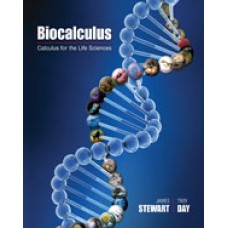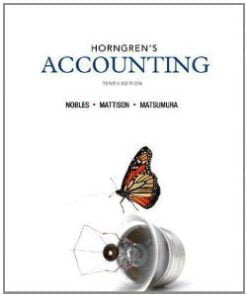Solution Manual for Biocalculus Calculus for Life Sciences, 1st Edition
$35.00 Original price was: $35.00.$26.50Current price is: $26.50.
Solution Manual for Biocalculus Calculus for Life Sciences, 1st Edition
Solution Manual for Biocalculus Calculus for Life Sciences, 1st Edition

Product details:
- ISBN-10 : 1133109632
- ISBN-13 : 978-1133109631
- Author: James Stewart
The chief goal in this textbook is to show students how calculus relates to biology, with a style that maintains rigor without being overly formal. The text motivates and illustrates the topics of calculus with examples drawn from many areas of biology, including genetics, biomechanics, medicine, pharmacology, physiology, ecology, epidemiology, and evolution, to name a few. Particular attention has been paid to ensuring that all applications of the mathematics are genuine, and references to the primary biological literature for many of these has been provided so that students and instructors can explore the applications in greater depth. Although the focus is on the interface between mathematics and the life sciences, the logical structure of the book is motivated by the mathematical material. Students will come away from a course based on this book with a sound knowledge of mathematics and an understanding of the importance of mathematical arguments. Equally important, they will also come away with a clear understanding of how these mathematical concepts and techniques are central in the life sciences.
Table contents:
- Ch 1: Functions and Sequences
- 1.1: Four Ways to Represent a Function
- 1.2: A Catalog of Essential Functions
- 1.3: New Functions from Old Functions
- 1.4: Exponential Functions
- 1.5: Logarithms; Semilog and Log-Log Plots
- 1.6: Sequences and Difference Equations
- Chapter 1: Review
- Ch 2: Limits
- 2.1: Limits of Sequences
- 2.2: Limits of Functions at Infinity
- 2.3: Limits of Functions at Finite Numbers
- 2.4: Limits: Algebraic Methods
- 2.5: Continuity
- Chapter 2: Review
- Ch 3: Derivatives
- 3.1: Derivatives and Rates of Change
- 3.2: The Derivative as a Function
- 3.3: Basic Differentiation Formulas
- 3.4: The Product and Quotient Rules
- 3.5: The Chain Rule
- 3.6: Exponential Growth and Decay
- 3.7: Derivatives of the Logarithmic and Inverse Tangent Functions
- 3.8: Linear Approximations and Taylor Polynomials
- Chapter 3: Review
- Ch 4: Applications of Derivatives
- 4.1: Maximum and Minimum Values
- 4.2: How Derivatives Affect the Shape of a Graph
- 4.3: L’Hospital’s Rule: Comparing Rates of Growth
- 4.4: Optimization Problems
- 4.5: Recursions: Equilibria and Stability
- 4.6: Antiderivatives
- Chapter 4: Review
- Ch 5: Integrals
- 5.1: Areas, Distances, and Pathogenesis
- 5.2: The Definite Integral
- 5.3: The Fundamental Theorem of Calculus
- 5.4: The Substitution Rule
- 5.5: Integration by Parts
- 5.6: Partial Fractions
- 5.7: Integration Using Tables and Computer Algebra Systems
- 5.8: Improper Integrals
- Chapter 5: Review
- Ch 6: Applications of Integrals
- 6.1: Areas between Curves
- 6.2: Average Values
- 6.3: Further Applications to Biology
- 6.4: Volumes
- Chapter 6: Review
- Ch 7: Differential Equations
- 7.1: Modeling with Differential Equations
- 7.2: Phase Plots, Equilibria, and Stability
- 7.3: Direction Fields and Euler’s Method
- 7.4: Separable Equations
- 7.5: Systems of Differential Equations
- 7.6: Phase Plane Analysis
- Chapter 7: Review
- Ch 8: Vectors and Matrix Models
- 8.1: Coordinate Systems
- 8.2: Vectors
- 8.3: The Dot Product
- 8.4: Matrix Algebra
- 8.5: Matrices and the Dynamics of Vectors
- 8.6: The Inverse and Determinant of a Matrix
- 8.7: Eigenvectors and Eigenvalues
- 8.8: Iterated Matrix Models
- Chapter 8: Review
- Ch 9: Multivariable Calculus
- 9.1: Functions of Several Variables
- 9.2: Partial Derivatives
- 9.3: Tangent Planes and Linear Approximations
- 9.4: The Chain Rule
- 9.5: Directional Derivatives and the Gradient Vector
- 9.6: Maximum and Minimum Values
- Chapter 9: Review
- Ch 10: Systems of Linear Differential Equations
- 10.1: Qualitative Analysis of Linear Systems
- 10.2: Solving Systems of Linear Differential Equations
- 10.3: Applications
- 10.4: Systems of Nonlinear Differential Equations
- Chapter 10: Review
- Ch 11: Descriptive Statistics
- 11.1: Numerical Descriptions of Data
- 11.2: Graphical Descriptions of Data
- 11.3: Relationships between Variables
- 11.4: Populations, Samples, and Inference
- Chapter 11: Review
- Ch 12: Probability
- 12.1: Principles of Counting
- 12.2: What is Probability?
- 12.3: Conditional Probability
- 12.4: Discrete Random Variables
- 12.5: Continuous Random Variables
- Chapter 12: Review
- Ch 13: Inferential Statistics
- 13.1: The Sampling Distribution
- 13.2: Confidence Intervals
- 13.3: Hypothesis Testing
- 13.4: Contingency Table Analysis
- Chapter 13: Review
- Appendixes
- A: Intervals, Inequalities, and Absolute Values
- B: Coordinate Geometry
- C: Trigonometry
- D: Precise Definitions of Limits
- E: A Few Proofs
- F: Sigma Notation
- G: Complex Numbers
- H: Statistical Tables
- Glossary of Biological Terms
- Answers to Odd-Numbered Exercises
- Biological Index
- Index
- Concept Check Answers
People also search:
what is calculus for life sciences
is calculus for life sciences hard
life science calculus vs calculus
calculus for life sciences vs calculus 1
Related products
Solution Manual
Solution Manual for Absolute C++, 5/E 5th Edition Walter Savitch
Solution Manual
Auditing A Risk Based-Approach to Conducting a Quality Audit Johnstone 10th Edition Solutions Manual
Solution Manual











